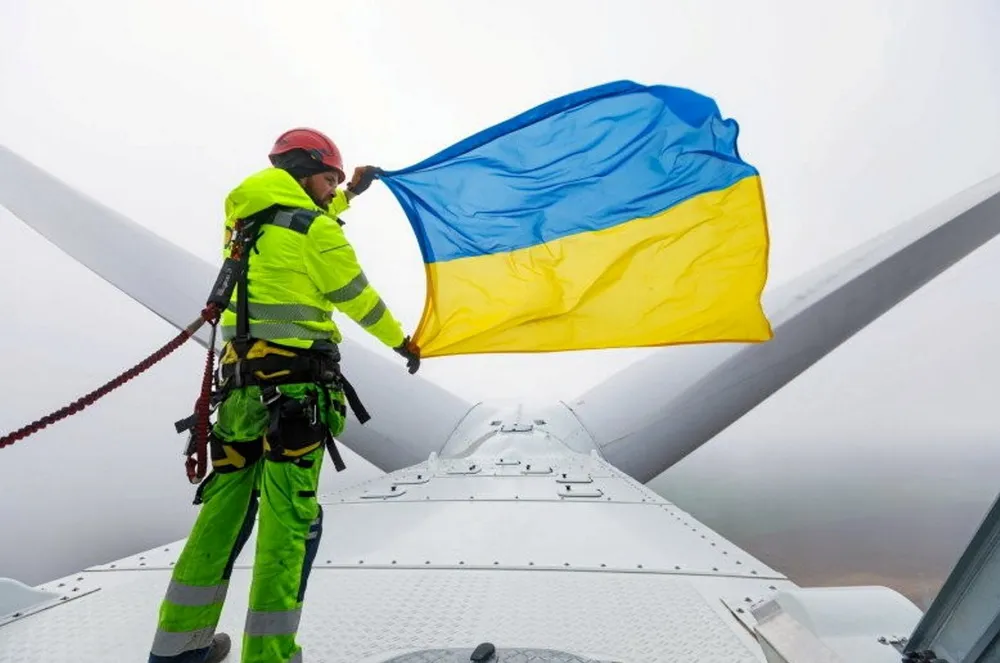'Standing tall': Ukraine's wind turbines are proving a key tactical advantage, says industry chief
Turbines have proved themselves to be much harder targets for enemy missiles, claims industry chief, but financing expansion in wartime brings challenges

As Russian missiles pick off Ukrainian power plants one by one, it is wind farms that have stood tall against the “focused devastation” of air strikes, showing their military advantage over conventional power sources, says the country’s wind chief.
Since launching its full-scale invasion in 2022, it is estimated Russia has destroyed at least half of Ukraine’s power generation capacity with missile and drone strikes, causing blackouts across the country.
Ukraine boasted around 55GW of grid capacity before the invasion, largely through nuclear and thermoelectric power plants. Officials now estimate this has dropped below 20GW.
From a military perspective, he said wind farms have shown “remarkable resilience against persistent drone and missile attacks” due to the turbines being spread out over huge distances.
“Wind power, with its inherent decentralisation, stands robust against the focused devastation that a single missile strike could wreak upon a thermoelectric plant.
“In the darkest times, wind turbines stand tall as harbingers of stability, hope and renewal.”
Advantage of wind turbines ‘cannot be overstated’
Wind farms have not escaped entirely unscathed from the onslaught on Ukraine’s energy infrastructure.
But while there are reports of 11 turbines having been damaged or destroyed this is a tiny fraction of more than 700 installed in Ukraine.
And even when a turbine is taken out, this has a “mere ripple effect” on energy production, said Konechenkov, “a stark contrast to the catastrophic blackout caused by the destruction of a centralised power station.
“The swiftness with which wind turbines can be deployed further underscores their superiority in wartime scenarios,” he said.
Turbines can be erected with a speed that “outpaces the lengthy reconstruction of thermoelectric plants, ensuring a rapid restoration of energy supplies essential for civilian and military operations.”
The economic advantage of wind power over fossil fuels “cannot be overstated,” he said.
Turbines do not require fuel, freeing nations from the “shackles of vulnerable supply chains” and boosting national security. They also have low maintenance costs and, of course, are better for the environment – “a silent boon even amidst the tumult of war.”
Konechenkov said his “strong opinion” is that destroyed thermoelectric plants should, where possible, be replaced with new wind farms using the newly available grid connection points.
How feasible is building turbines in wartime?
It is one thing to say that thermoelectric plants should be replaced with wind turbines – another thing entirely to do it.
Ukraine had reached nearly 1.7GW of wind capacity before the war – excluding capacity in already annexed areas of the Donetsk and Luhansk regions and Crimea – with around half of the players in the market foreign companies.
But now those same companies are, understandably, wary of pushing more money into in a market where a Russian missile could quite literally send their investment up in smoke.
Aside from the direct physical threats, Konechenkov said developers have highlighted the difficulties in securing financing and war insurance for such risky projects, logistical issues and lengthy permitting procedures.
Looking at things another way, the current minimal competition for wind capacity in Ukraine also makes it an “opportune time for investment,” said Konechenkov.
He also highlights the “bankable wind potential across nearly the entire country” and the fact that Ukraine is “currently the world's largest construction site,” with a “vast resource” of available labour.
What more support is needed?
Crucial to rolling out turbines “at the pace the country needs” is finding a financial and commercial model for investment that can withstand the ravages of war, said Konechenkov.
There needs to be a “guaranteed offtake” for electricity from wind farms for long enough for investors to recoup loans made and interest, he said.
Currently there is a “very limited” pool of bankable offtakers in Ukraine that would only cover a very small portion of the generation the country needs.
“In addition, those who are bankable are not ready to commit for the long term.”
Ukraine last year finalised legislation to establish a contracts for difference mechanism for power providers. But Konechenkov said this has not been implemented because Ukraine currently lacks “capabilities to provide state support.”
The UWEA has proposed creating a temporary financial instrument that would “provide certainty for the lenders by guaranteeing the floor price of the electricity.”
International financial institutions, such as the World Bank and International Monetary Fund, domestic backers and the Ukrainian state would have to set up a fund to support this, he said.
Ultimately, Konechenkov said that rebuilding Ukraine’s energy infrastructure with renewables is “more than a practical necessity.”
In the “the throes of wartime,” wind turbines have emerged as a “beacon of hope and resilience.”
(Copyright)